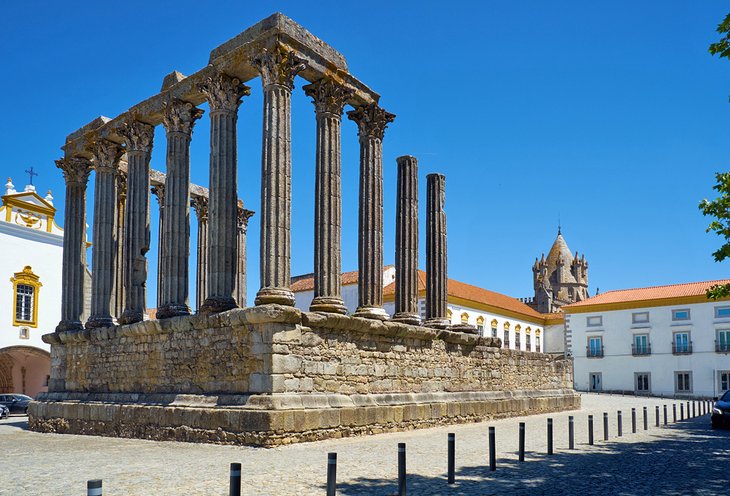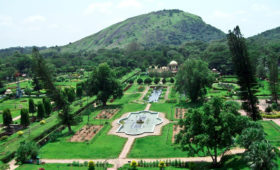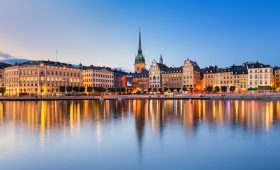Excellent holiday attractions and car rental providers in Portugal: Translated as the Paiva Walkways, this award-winning facility ticks all the green boxes. Located outside the town of Arouca, a 70-kilometer drive north of Aveiro in central Portugal, the Paiva Walkways provide a challenging but highly rewarding eight-kilometer hike over an elevated boardwalk that dips, climbs, and meanders through the Arouca Geopark – an unspoiled landscape of outstanding beauty, and a biodiversity hot spot. The walk commences at Areinho and partway follows the pristine River Paiva downstream. Very soon, you’re hiking through a rugged, seldom-seen environment of peaceful, verdant woodland and deep, yawning gorges. Along the way, you pass tumbling waterfalls and serene, mirror-like pools. Quite often the trek involves negotiating long flights of zigzagging steps over steep inclines: the route really does test stamina and physical fitness. The walk takes around 2.5 hours to complete, ending in Espiunca. Remember to pack sunscreen, energy snacks, and plenty of water. If you are looking for a vehicle to travel between Portugal’s holiday destinations you can find extra info at rent a car in Portugal
Not far from the Portuguese capital, off the coast of Estoril, is the small beach resort town of Cascais. Cascais was the summer residence of the royal family during the turn of the 19th and 20th centuries, making it a pioneer destination in Portugal. Today it is one of Portugal’s most prestigious resorts and has retained the unique atmosphere of the Middle Ages. The land where today’s urban life in Cascais is bustling was settled by the first inhabitants in the 12th century. Located on the Atlantic coast, close to the capital, the settlement quickly became prosperous and was the focus of many conflicts between different nations. Today, this historic center is literally filled with architectural treasures. So if you plan a trip to Cascais you’ll certainly find plenty to see in Portugal, with plenty to choose from.
Travel destinations and car rental providers in Portugal today: Belem Tower, also known as the Tower of St. Vincent, sits on what once was an island in the Tagus River in Lisbon, the capital of Portugal. Dating back to 1515, the imposing tower was built both to defend Lisbon from invaders and to welcome the city’s friends. Built in the Age of Discovery, the four-story limestone tower has a bastion connected to it; the bastion had space for 17 cannons that could fire long range shots. A statue of Our Lady of Safe Homecoming, designed to protect sailors on their voyages, faces the river. The Pena National Palace seems like a fairy tale castle as it stands above the clouds on overcast days. Yet, sitting atop a hill in Sintra, it can be seen from Lisbon on a clear day.
Dominating the charming riverside town of Tomar is a mighty castle that shields the Convento do Cristo, one of Portugal’s standout historic attractions. Founded in 1160 as the headquarters of the Order of the Knights Templar, the Convent of Christ is as awe-inspiring as it is mysterious, its masonic heritage tangible and beguiling. At its center is the medieval Charola, the original Templar church, richly decorated and exuding all the strange symbolism associated with the Order of Christ. The 16th-century cloisters bewitch with Manueline flourishes and tease visitors with their concealed spiral staircases. And the convent’s magnificent Manueline window, designed by master sculptor Diogo de Arruda, remains one of the most architecturally appealing aspects of any building found in Portugal.
Vacation attractions and car rental providers in Portugal today: The castle itself attracts many tourists with its crenellated walls, preserved from the Middle Ages to the present day in remarkably good condition. The castle as we see it today was built in the 13th century and before that, during the Roman Empire, there were public baths and a square which played the role of political center of the settlement. After the fall of the Roman Empire, when the Visigoths came to power, a fortress was built on this site, around which the settlement was formed, the future city of Obidos. In the 8th century the fortress fell into the hands of the Muslims, and it was only in the 13th century that King Afonso of Portugal recaptured the edifice. Later, for several centuries, the fortress was a favorite place for royal festivities and celebrations.
Nestling in the lap of a wooded mountain range, Sintra’s stunning location is reason enough to visit this charming, verdant town. Indeed, UNESCO acknowledges the destination as a World Heritage cultural landscape such is its beauty and the significance of the collection of historic visitor attractions clustered in and around the old town, Sintra Velha. A favorite summer retreat for the kings and queens of Portugal and an alluring destination for numerous writers and poets, including Lord Byron and William Beckford, Sintra exudes romance. The old town is a maze of cobbled lanes lined with handsome town houses painted in pastel hues of pink, mustard, and lilac. The narrow streets surround a pretty central square that’s dominated by the wonderful Palácio Nacional de Sintra. Easily recognized by its huge conical chimneys, Sintra’s National Palace dates from the late 14th century and is the oldest surviving palace in Portugal. Regally furnished, the building is set over several floors, many conveying a unique theme and decorated accordingly. A highlight is the magnificent Sala dos Brasões, a glittering domed hall embellished with the coats of arms of 72 noble Portuguese families. Read more details on https://www.carrentalinportugal.com/.



